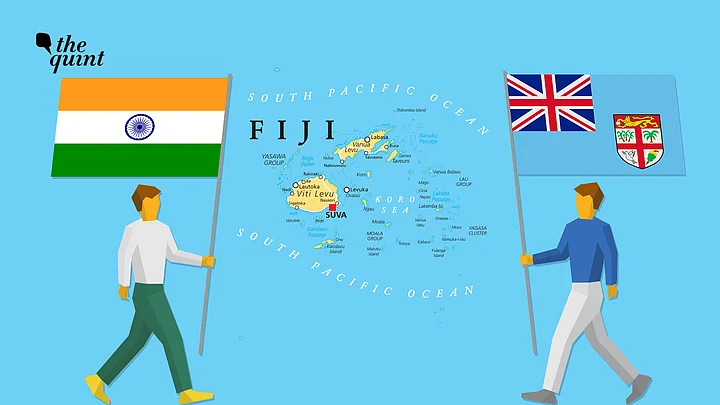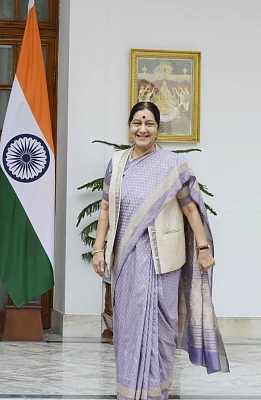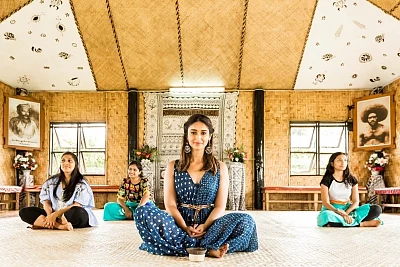Sanjay Sen fondly reminisces his dadi as he croons, '… kaise khelen jaiyo sawaan ma, kajaria badariya ghir aayi nandi…,' – a Bhojpuri song he heard his grandmother sing often as a child in Laukuto city in Fiji.
Sanjay’s ancestors made Fiji their home, a picture perfect archipelago of over 330 islands in the South Pacific. Four generations back, his great grandfather Mewababu Sen reached Fiji by the first labour transport ship ‘Leonidas’ that brought Indian indentured workers to Fiji, then a British colony.

Sanjay Sen's great grandparents.
(Photo Courtesy: Sanjay Sen)
On 14 May 1879 Mewababu set foot in Levuka, Fiji after a long sea journey of three months, having left Calcutta on 28 January 1879.
‘Leonidas’ was the first of 42 ships that carried 60,965 Indians to Fiji. They were recruited to work in the colony’s sugarcane fields, with deceitful lure of riches, promises of a short journey, and return.
As most of the workers were illiterate, the system came to be known as ‘Girmit’ (derived from the word ‘agreement’), and thus the people were referred to as ‘Girmitiyas’. Indenture was as cruel as slavery. Though it is 100 years since indenture was abolished in Fiji, but the pain of the harsh, exploitative system comes up in family conversations in the Fijian Indian communities, even generations later.
Initial recruitment was from famine and flood struck districts of Bihar and Eastern Uttar Pradesh, later expanding to South and West India. Hence the main language of Indo-Fijians was Bhojpuri. “Aaj bhi Bhojpuri boli jaati hai. Main Bengali kum, Bhojpuri zyada bolta hun. South Indian bhi the, Punjabi bhi the (Even today Bhojpuri is widely spoken. I speak in Bhojpuri more than I do in Bengali. South Indians were there, as were Punjabis). Bhojpuri was the language to communicate,” says Sanjay Sen.
Awadhi and Bhojpuri, mixed with South Asian influences in Fiji’s melting pot produced a distinct lingua franca, which is better known as Fiji Hindi – a language taught in schools.
Keeping the Music Alive in Their Hearts

Sanjay Sen (left) singing at an event.
(Photo Courtesy: Sanjay Sen)
Sen’s ancestors carried their music in their hearts during their voyage over ‘kala pani’ from India to Fiji, and kept it alive through their struggles as cane cutters.
With a shared victimhood of indenture and a deep longing for their motherland India, the Fijian Indian community continued to hold their music dear, even after indenture was abolished.
”My family has been musically inclined. My dad was also a singer. We started having musical evenings, get-togethers with food and music. We listened to Radio Fiji, the only country outside India, to play Hindi music round the clock. They used to connect to Radio Ceylon and to All India Radio. Hindustani music and bhajans are popular in Fiji.”Sanjay Sen

Sanjay Sen's parents in Lautuka, Fiji. Hari Inder Sen and Chandra Sen.
(Photo Courtesy: Sanjay Sen)
Like his forefathers, Sen too made a voyage by bringing his music further overseas to California, his new home land, where he has gained popularity as a Bhojpuri singer. Thousands of others too, left the islands, their second home, after the community faced political persecution, once Fiji became an independent country in 1970.
The entrepreneurial spirit of the Girmitiyas had made them large farm owners and traders, once the cruel indentured system was abolished.
Their prominence and colonial politics ensured that the relationship between Indo-Fijians, almost half the population, and native Fijians was precarious. When military coups became the norm in the 1980s and 1990s, Indo-Fijians became sojourners again, finding asylum near Australia, New Zealand, and far away North America. The largest community of Indo-Fijians in USA are in the San Francisco Bay Area.
Of Religious Ties and Caste Identities
Indo-Fijians, some of whom haven’t set foot in India for generations, are devout followers of Hinduism, practising its various rituals and festivals. Jagat Guru, also referred to as Swamiji, is a Bay Area-based religious leader who was born in Nausori, Fiji in 1956, and runs seven temples in US and Fiji. His father Gammu Maharaj (Gaumukh Ram Sharma) was born in India’s Nandgaon in 1891, and reached Fiji when he was 24 years old.
He sailed from Allahabad in 1915 on a ship, MUTLAH IV, says Jagat Guru.
Indian Naval ship reaches Fiji

"The British were not taking any Brahmins to Fiji, one reason was that Brahmins were not known to work hard. They were known to do puja and eat a lot. My pujya Pitaji changed his name, wrapped a Ramayan and Mahabharata in his dhoti to bring it to Fiji. He continued work as an indentured labourer, but the community knew him as a religious leader. After 1940s, they were allowed to own property. Pitaji bought 180 acres of freehold property and built a big temple after 20 years of hard work,” Jagat Guru added.

Fijian Indian temple in San Francisco, Bay Area.
(Photo: Sourced by Savita Patel)
The story of Lord Rama’s exile speaks to this diaspora’s experience characterised by loss and trauma, a persistent mourning for the home left behind, a never healing wound passed down from generation to generation.
Indo-Fijians refer to their severance from India as having been ‘banished’ like Rama from a country they can never return to.
Gammu Maharaj helped preserve their religious traditions in Fiji, which his son is now doing in California. The pundits were the only group that retained their caste identity in Fiji. With demographic restraints of being a small community, only caste-endogamous marriages were common.
To not restrict the pool, Indo-Fijians who in the initial years only married within their ‘jati’, later abandoned the divisive caste system.
“The caste system broke and created a big tradition of naming your child with whole different (not indicative of caste) name,” says Kunal Prasad who is a SF Bay Area-based theatre educator.
Honorary Fijian Consul to USA, Jay Singh agrees that today much of the segregation has been cast aside. “The distinction between Indian sub-communities does not happen, like Punjabis wanting to marry Punjabis only. Non cross marriages are common. If you didn’t know their name and went to a function in Fiji, you can’t tell whether they are Hindus, Muslims or Christians. They tie rakhis to each other,” he said.
Cultural Ties
Dislocated by a double trans-national migration, Fijian-Indian Americans have not severed ties with their culture.
Fijian temples, grocery stores, and apparel shops in the San Francisco Bay Area serve the strong community of 50,000 existing alongside separate establishments that cater to subcontinental Indian Americans. Kunal Prasad says, “Religion, language, and food was my understanding of India. It was concrete, sensual. Music and Bollywood films played a huge part. As a place India was abstract for me. We had a sense of community – different from Indians from India. We call it Fijian-Indian culture.”

A Fijian Indian store in Bay Area.
(Photo: Sourced by Savita Patel)
Indo-Fijians who migrated to USA mostly hold blue collared jobs. Second generation Indo-Fijians in US are diversifying into other careers, adds Prasad.
”A majority of Indo-Fijian community are small business owners, trades people, bus drivers, florists, people who do industrial and manufacturing jobs, hold middle management positions. It is a demographic I am aware of. My dad was an upholsterer, my mom worked in electronic testing, my aunts ran small businesses. My generation, my cousins have gone into medicine, engineering,” he says, rejecting the ‘model minority’ construct that comes up in the context of subcontinental Indian Americans.
”We hear about movers and shakers. It comes with a little bit of class tension. The idea of a model minority, I have never heard that phrase in the Indian-Fijian community – they don’t identify with it at all. That is something that people with money say, self-serving grandiosity.”Kunal Prasad
Shared Ethnicity, Yet Far Apart
Indo-Fijians and the recently immigrated Indians in US, practise the same religions, understand each other’s languages, and have a mutual fondness, but don’t mingle.
Social distance from subcontinental Indians is too great to be narrowed by a shared ethnicity.
With the Indo-Fijian love for Bollywood and Indian khana, SF Bay Area-based cosmetologist Aparna who considers herself very ‘Indian’, had married a California-based Punjabi from India, who she befriended in high school.
"It was very important to my family that the person was Indian, they won’t allow otherwise. First preference was Hindu from Fiji. But the Indo-Fijian community wasn’t that large here then (2004). We had a wedding reception in Delhi, as I had seen in Bollywood movies. But his family in India looked down on me. They don’t know what Fijian meant. They thought I was something else, even though I did offer all the respect and spoke in Hindi."Aparna
For Aparna, whose ancestors moved to Fiji from India five generations back, finding happiness with an Indian husband from India wasn't easy. "If I started all over again, I will go for a Fijian-Indian husband. It is a lot easier to adjust as the culture is not different,” she said.
Aparna has fans in the SF Bay Area’s Indo-Fijian community, because of her Indian cooking skills. The cuisine is hot and spicy, India being the base from which it arose. Surrounded by the Pacific Ocean, the island's seafood influences got blended with Hawaiian styles. British heritage is evident in puddings and pies as favourite Indo-Fijian desserts. With the Indians in Fiji coming from many different traditions, the cuisine has become a mix of influences from around the globe, distinct from ‘Indian-Indian’ food.
“Going to an Indian restaurant here, we don’t like the food. It’s not authentic and its very creamy. Our Indian cooking is natural – Fiji style. I got married into an Indian family and learnt Punjabi style. Fiji style of cooking has a lot of sea food, with coconut, more vegetables,” shares Aparna.

A Fijian Indian food truck.
(Photo: Sourced by Savita Patel)
The community felt a sense of pride when Indo-Fijian Justin Narayan won Masterchef Australia 13 trophy.
Even though migration over centuries has led to losing all family contacts in India, these double-hyphenated, twice removed, Fijian-Indian Americans, fondly remember the land that their forefathers sailed away from, says singer Sanjay Sen. “We are always Indian. We grew up celebrating India’s Independence Day and Republic Day in schools in Fiji. Matribhumi hai, abhi bhi kuch hota hai India ko, to humko krodh aata hai. Pardes mein hum hain, lekin Hindustani se Hindustan nahi nikal sakta. (It's my motherland so if anything happens to the country it angers me. We're in a foreign land but you can't take away the essence of being an Indian).”
(Savita Patel is a senior journalist and producer, who produced ‘Worldview India’, a weekly international affairs show, and produced ‘Across Seven Seas’, a diaspora show, both with World Report, aired on DD. She has also covered stories for Voice of America TV from California. She’s currently based in the San Francisco Bay Area. She tweets @SsavitaPatel. This is an opinion piece, and the views expressed are the author’s own. The Quint neither endorses nor is responsible for them.)
(At The Quint, we question everything. Play an active role in shaping our journalism by becoming a member today.)






